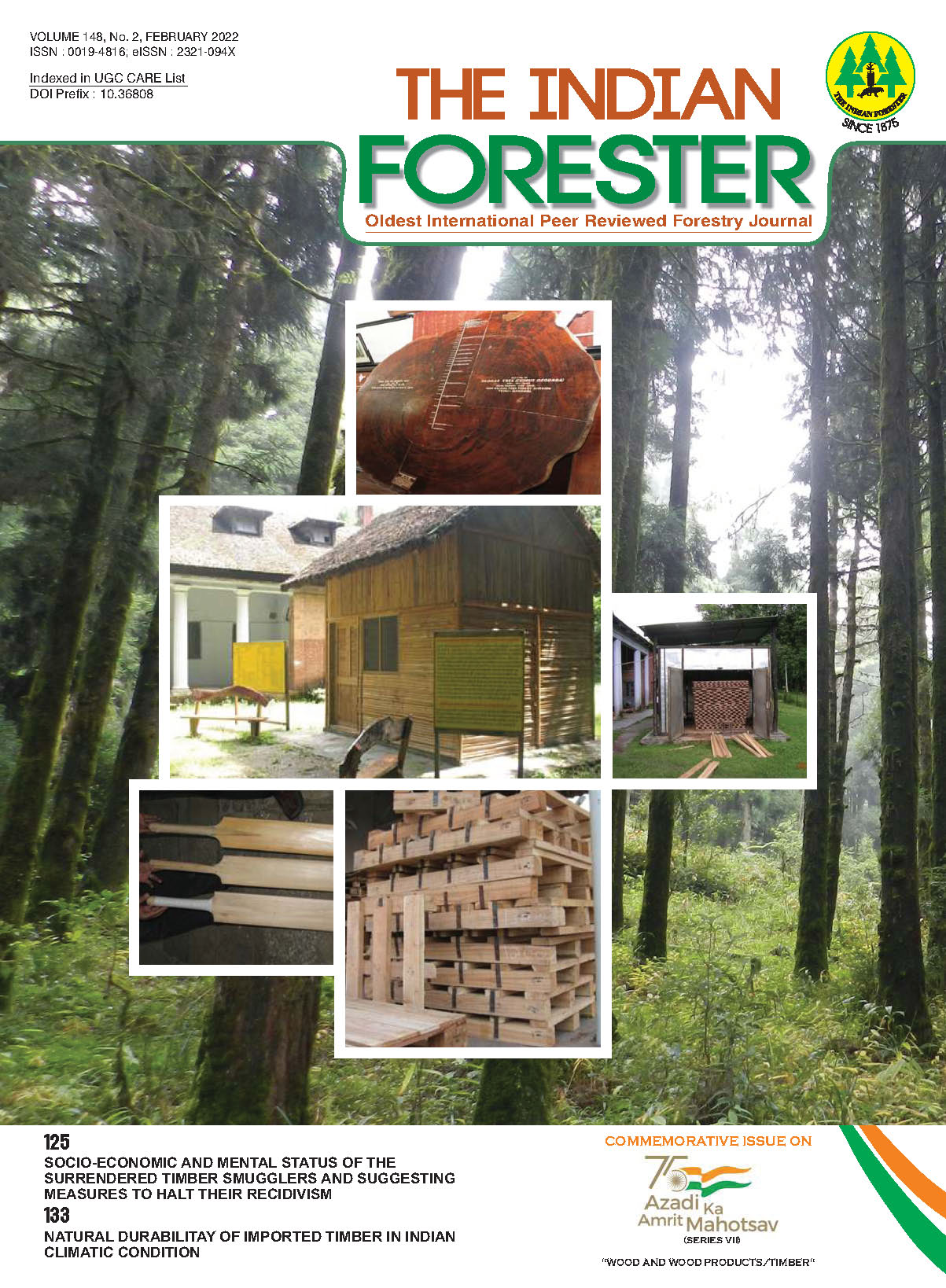Qualitative Wood Anatomical Study of Disjunct Species from Contrasting Biogeographical Zones of India
DOI:
https://doi.org/10.36808/if/2022/v148i2/160757Keywords:
Disjunct Species, IAWA, Qualitative Features, Vessel Features, Wood Anatomy.Abstract
Water availability influences the wood anatomical features especially vessel characteristics in a particular zone. This leads to various adaptive strategies related to wood anatomy, adopted by species for their successful establishment at different environmental conditions. The present study analyzes qualitative features of the vessel element of disjunct species belonging to different biogeographical zones of India and to observe the anatomical changes exhibited by the species. Disjunct taxon shows a peculiar distribution where a taxon is widely separated geographically or their distribution is not continuous.
The present study examines the qualitative wood anatomy of twenty one wood samples of five disjunct species selected from various biogeographical zones of India. Standard laboratory procedures were followed to prepare the permanent slides. Vessel characteristics for all the selected samples were examined from these permanent slides as per the terminology list of microscopic features for hardwood identification given by the International Association of Wood Anatomists. The results indicated absence of intraspecific variations between the species occurring at different biogeographical zones. This shows the conservative nature of qualitative wood anatomical features.
References
Alves E.S., and Angyalossy-Alfonso V. (2000). Ecological trends in the wood anatomy of some Brazilian species. 1. Growth rings and vessels, IAWA journal, 21(1): 3-30.
Beeckman H. (2016). Wood anatomy and trait-based ecology. IAWA journal, 37 (2):127-151.
Brockerhoff E.G., Barbaro L., Castagneyrol B., Forrester D.I., Gardiner B., GonzálezOlabarria J.R., Lyver P.O.B., Meurisse N., Oxbrough A., Taki H., Thompson I.D., Plas F.V.D. and Jactel H. (2017). Forest biodiversity, ecosystem functioning and the provision of ecosystem services, Biodiversity Conservation, 26:3005-3035.
Campbell G., Rabelo G.R. and Cunha M.D. (2016). Ecological significance of wood anatomy of Alseis pickelii Pilg. & Schmale (Rubiaceae) in a Tropical Dry Forest, Acta Botanica Brasilica, 30(1): 124-130.
Carlquist S. (2001). Comparative Wood Anatomy: Systematic, Ecological, and Evolutionary Aspects of Dicotyledon. 2nd Edition. Springer-Verlag Berlin Heidelberg, 448 pp.
Cruiziat P., Cochard H. and Améglio T. (2002). Hydraulic architecture of trees: main concepts and results, Annals of forest science, 59(7): 723-752.
Fonti P., Von Arx G., GarcÃa-González I., Eilmann B., SassKlaassen U., Gärtner H. and Eckstein D. (2010). Studying global change through investigation of the plastic responses of xylem anatomy in tree rings, New Phytologist, 185(1): 42-53.
Gupta V.K. and Verma A.K. (2013). Animal Diversity, Natural History, and Conservation. New Delhi: Daya Publishing House, 503 pp.
Herendeen P.S. and Miller R.B. (2000). Utility of wood anatomical characters in cladistic analyses, IAWA journal, 21(3): 247-276.
Jansen S., Baas P., Gasson P., Lens F. and Smets E. (2004). Variation in xylem structure from tropics to tundra: evidence from vestured pits, Proceedings of the National Academy of Sciences, 101 (23): 8833-8837.
Jansen S., Choat B. and Pletsers A. (2009). Morphological variation of intervessel pit membranes and implications to xylem function in angiosperms, American journal of botany, 96(2): 409-419.
Longui E.L., Pires G.T., Freitas M.L.M., Romeiro D., Florsheim S.M.B. and Zanatto A.C.S. (2017). Genetic versus environmental influence on radial variation in Myracrodruon urundeuva wood, Floresta e Ambiente, 24: e00119114.
Marciszewska K. and Tulik M. (2013). Hydraulic efficiency and safety of xylem sap flow in relation to water stress in woody plants. In: Hydraulic Conductivity. Janeza Trdine, Croatia, 1-32 pp.
Metcalfe C.R. and Chalk L. (1957). Anatomy of the Dicotyledons. Volume 2. Clarendon Press, Oxford, 557 pp.
Mori A.S., Lertzman K.P. and Gustafsson L. (2017). Biodiversity and ecosystem services in forest ecosystems: a research agenda for applied forest ecology, Journal of Applied Ecology, 54(1): 12-27.
Puri R., Barman P. and Geeta R. (2016). A phylogenetic approach toward the understanding of disjunct distributions of plant taxa in Western Ghats and northeastern India, Rheedea, 26(2): 99-114.
Singh J.S. and Kushwaha S.P.S. (2008). Forest biodiversity and its conservation in India, International Forestry Review, 10(2): 292-304.
Sonsin J. O., Gasson P.E., Barros C.F. and Marcati C.R. (2012). A comparison of the wood anatomy of 11 species from two cerrado habitats (cerrado ss and adjacent gallery forest), Botanical Journal of the Linnean Society, 170(2): 257-276.
Wheeler, E.A., Baas, P., and Gasson, P.E. (eds.) 1989. IAWA list of microscopic features for hardwood identification. IAWA Journal, 10(3): 219-232.
Zimmermann M.H. (1983). Xylem structure and the ascent of sap. Springer-Verlag, Berlin, Heidelberg, New York, Tokyo, 146 pp.
Downloads
Downloads
Additional Files
Published
How to Cite
Issue
Section
License
Unless otherwise stated, copyright or similar rights in all materials presented on the site, including graphical images, are owned by Indian Forester.





